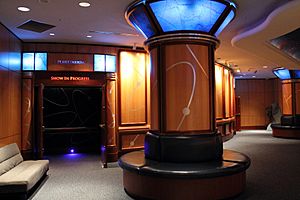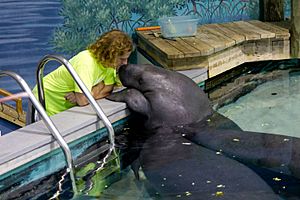Bishop Museum of Science and Nature facts for kids
 |
|
| Former name | South Florida Museum |
|---|---|
| Established | 1946 |
| Location | 201 10th Street West Bradenton, Florida |
| Type | Anthropology, aquarium, astronomy, planetarium, archeology, children's, natural history |
| Public transit access | Manatee County Area Transit (MCAT) |
The Bishop Museum of Science and Nature is a cool place to learn about science and nature! It's located in Bradenton, Florida. This museum used to be called the South Florida Museum.
It focuses on the history of Florida's Gulf Coast, from ancient times to today. You can see many different exhibits here. The museum also has special changing exhibits that are updated regularly.
One of the most popular parts of the Bishop Museum is The Planetarium. It also has the Parker Manatee Rehabilitation Habitat. This habitat helps sick or injured manatees get better so they can go back to the wild. Over 40 manatees have been helped here since 1998!
Contents
Museum History
The Bishop Museum started in 1946. It opened its doors in 1947 on Bradenton's Memorial Pier. At first, it showed old tools and pottery from Florida's first people. It also had items about the history of southwest Florida.
In 1949, a special pool was added for a baby manatee named Baby Snoots. This little manatee quickly became very popular! The museum grew fast and needed more space.
New Location and Growth
Construction began on a new, bigger building. This new place would have a larger manatee pool and a planetarium. The new museum opened in October 1966.
In 1980, the Spanish Plaza opened. This area showed off the region's Spanish heritage. It even had a copy of Hernando DeSoto's home from Spain.
In 1993, the Parker Manatee Aquarium joined the museum complex. It had a huge 60,000-gallon pool. This pool could hold up to three adult manatees. It became part of a network that helps injured manatees.
Modern Updates and Challenges
Around 2000, the museum worked to update its exhibits. This made it a top natural and cultural history museum. In 2001, a fire damaged the Planetarium and some offices.
After a lot of hard work and help from the community, a new planetarium opened in 2005. It had amazing new technology. More renovations happened in 2006. These updates added new galleries about Florida's environment and history.
The museum celebrated its 65th birthday in 2012. On April 10, 2019, the South Florida Museum changed its name. It became The Bishop Museum of Science and Nature.
Tallant Collection
The museum's first collection came from a man named Montague Tallant. He owned a furniture store in Bradenton. He loved to find old artifacts all over Florida.
His collection included ancient pottery, stone tools, and items from early Spanish explorers. In the 1930s, a Smithsonian expert named Matthew Stirling became his friend. Stirling helped Tallant learn more about archaeology.
Tallant started showing his collection to the public in 1935. People loved seeing these historical items. In 1941, he opened his own small museum.
After World War II, tourism slowed down. Tallant decided to sell his collection. He wanted it to stay in the local area. In 1948, the collection became part of the new South Florida Museum. Many of these items are still on display today. They help us learn about Florida's past.
Bishop Planetarium
In the 1960s, plans were made for a new museum building. Dr. W.D. Sugg, a local doctor and museum founder, really wanted a planetarium. He imagined a place that could be both an auditorium and a planetarium. He was inspired by the Hayden Planetarium in New York City.
The Bishop Planetarium opened in 1966. It was named after Edward E. "Ned" Bishop, a generous supporter. His wife, Lillian "Patty" Bishop, gave a lot of money for its construction.
The museum wanted the planetarium to look special. They built a unique concrete dome that stands out. This dome helped protect the museum during a fire in 2001. The fire damaged the inside of the planetarium.
After a big renovation, the planetarium reopened in 2005. It had new projection and sound systems. In 2013, it got an even better projection system. This made the shows 25 times sharper and five times brighter! Now, it's one of the best planetariums around.
Spanish Plaza
In 1967, Dr. W.D. Sugg wanted to connect the museum's Spanish Courtyard with the annual De Soto celebration. He planned trips to Barcarrota, Spain. The goal was to bring back items from the time of Hernando DeSoto.
These efforts led to the creation of the Spanish Plaza, which opened in 1980. It used materials from an old hotel that was being taken down. The plaza has pink marble and other cool architectural details.
Today, the Spanish Plaza is used for museum events. It also hosts weddings in its small replica chapel.
Parker Manatee Rehabilitation Habitat
The museum has had a manatee habitat almost since it started. But as people learned more about manatee care, a bigger and better facility was needed. Plans for a new wing began in 1979.
This new wing opened in 1993. It was named the Parker Manatee Rehabilitation Habitat in 1994. It honored Mary Parker, a long-time supporter of the museum.
The new habitat has a 60,000-gallon tank. You can view the manatees both above and below the water! It also has a special medical pool. This pool helps veterinarians check on the manatees easily. The main pool has both shallow and deep areas. This lets the manatees act more naturally.
The museum became a "Level 2" manatee rehabilitation facility in 1997. This means they can care for manatees that are recovering but not ready for the wild. They work with the Manatee Rescue & Rehabilitation Partnership. Since 1997, the museum has helped over 25 manatees return to their ocean home.
Snooty the Manatee
Snooty was a famous Florida Manatee who lived at the museum. He was born on July 21, 1948. Snooty was one of the first manatees ever born in captivity. He became the oldest known manatee in the world!
Because Snooty couldn't be released into the wild, he was the only permanent manatee resident. He was also one of the few captive manatees who could interact with human handlers. This made him very important for manatee research and education.
Snooty passed away on July 23, 2017, just after his 69th birthday. He drowned after getting into an area he shouldn't have. The museum later found that a hatch door was not properly secured. This sad event led to changes in how the museum managed its manatee care.
See also
 In Spanish: Museo del sur de la Florida para niños
In Spanish: Museo del sur de la Florida para niños




